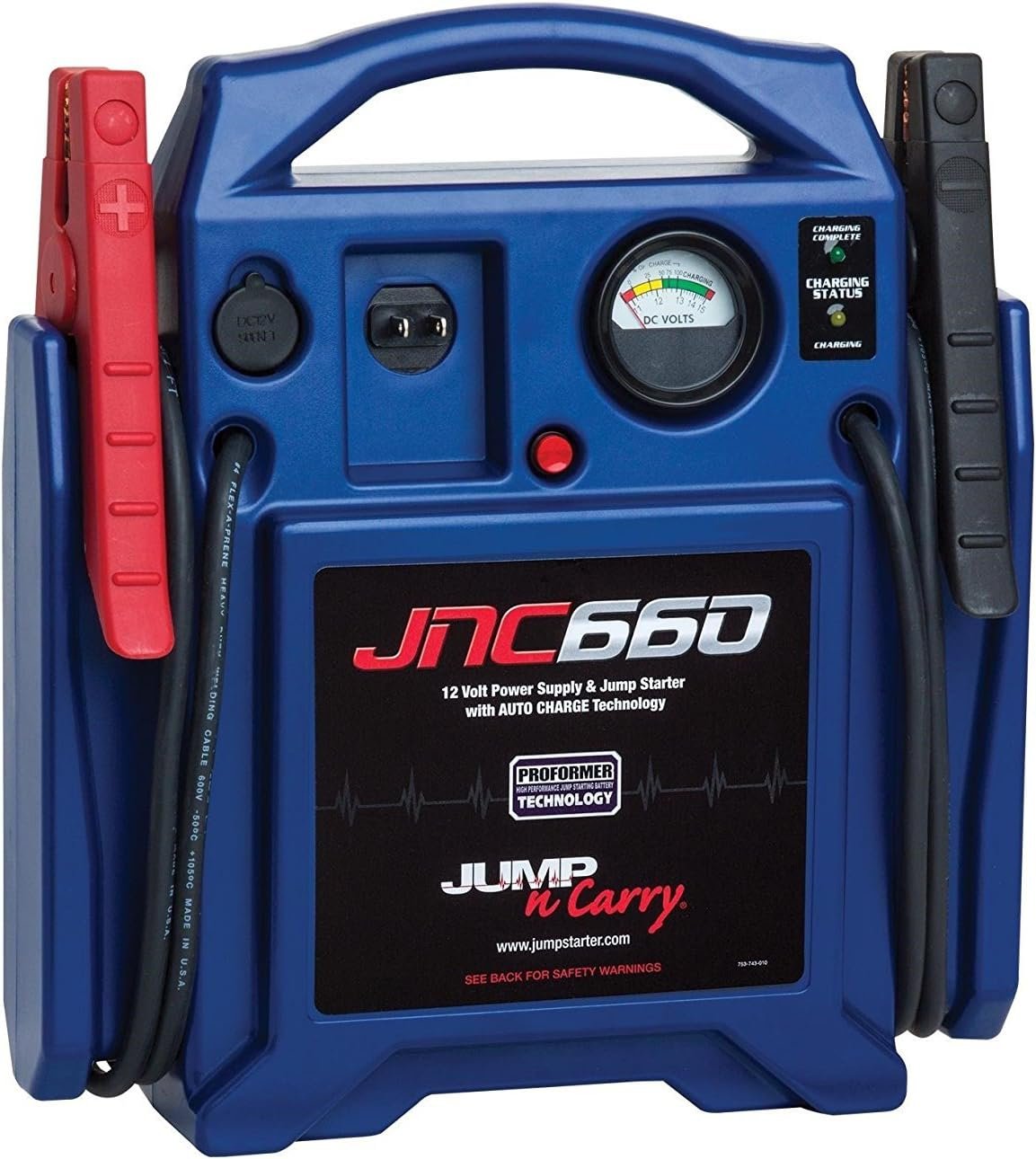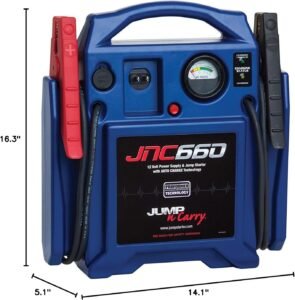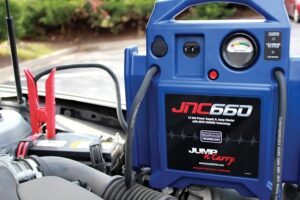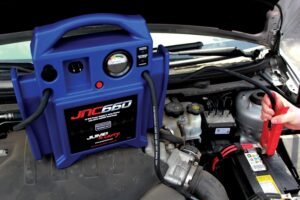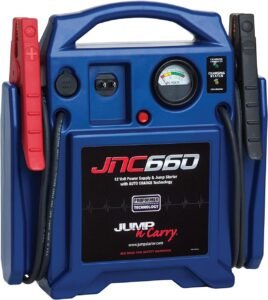Clore JNC660 Jump-N-Carry Review
Clore JNC660 Jump-N-Carry Review
Have you ever been left staring at a dashboard of warning lights and wished you had a dependable jump starter ready to save your day?
Quick snapshot of the Clore Automotive Jump-N-Carry JNC660 1700 Peak Amp 12 Volt Jump Starter , Blue
You’ll find this unit positioned as a rugged, work-ready jump starter that aims to handle demanding conditions and multiple jump starts without fuss. The core promise is simple: powerful starting power, built-in charging, and durable hardware that you can rely on when your vehicle battery fails.
Key specifications and features
This section gives you a clear snapshot of the technical details so you can quickly judge fit for your needs. Each spec matters for what the unit can and can’t do, so pay attention to the battery capacity, peak/cranking amps, cable gauge, and accessory ports.
| Feature | Details |
|---|---|
| Product name | Clore Automotive Jump-N-Carry JNC660 1700 Peak Amp 12 Volt Jump Starter , Blue |
| Peak amps | 1,700 Peak Amps |
| Cranking amps | 425 Cranking Amps |
| Battery | 22Ah Clore PROFORMER battery |
| Cables | 46″ heavy-duty cables (listing includes both #2 AWG and #4 AWG references — see note below) |
| Voltmeter | Onboard voltmeter to show charge status |
| Accessory ports | 12V DC outlet to power accessories; DC input to recharge internal battery |
| Charging | Built-in automatic charger |
| Clamps | Industrial-grade clamps |
| Intended use | Powerful portable starter for cars and light trucks; multiple jump starts and cold-weather starts claimed |
| Sales restriction note | Not for sale in Catalina Island (per product listing) |
Note about cable gauge confusion: the product description includes references to both #2 AWG and #4 AWG cable sizes. If cable gauge is critical for your intended use, verify the seller’s specific listing before purchase. #2 AWG is thicker and offers lower resistance and better high-current delivery; #4 AWG is still heavy-duty but slightly slimmer.
What you get in the box
You’ll receive the jump starter unit with its built-in battery, the attached heavy-duty cables and clamps, and the integrated voltmeter and charger connections. The unit typically includes user documentation and a power cord for keeping the internal battery charged via the built-in automatic charger.
Battery technology and power delivery
Understanding the 22Ah PROFORMER battery and how 1,700 peak amps translate to real-world starts helps you make a practical decision. The 22Ah rating indicates a relatively large lead-acid battery designed for delivering high current in short bursts, which is exactly what jump starting requires.
What “1700 peak” and “425 cranking” mean to you
Peak amps are the maximum short burst current the unit can deliver, useful for overcoming the initial resistance of a frozen or depleted battery. Cranking amps are a more realistic measure for sustained current delivery during engine cranking. In practice, the 1,700 peak amps help with tough starts while the 425 cranking amps sustain the engine until it runs on its own.
Real-world expectations for starting power
You can expect reliable performance for most passenger vehicles and many light trucks under normal conditions, and improved reliability in cold environments compared with weaker units. If you own a very large gasoline engine or a diesel with high cold-cranking requirements, confirm compatibility before relying on any single portable starter as your only backup.
Performance in cold and demanding conditions
This unit is marketed as being able to perform in very cold weather and handle multiple jump starts, which matters if you live in a place with harsh winters. The heavy-duty battery and thick cables are designed to reduce voltage drop and deliver current where it’s needed most.
Cold-weather capability explained
Cold temperatures reduce battery chemical activity and make engines harder to crank; more current is required to turn them over. The JNC660’s high peak amp rating and rugged battery help you get the engine spinning even when temperatures are low, so you’re less likely to be stranded on a cold morning.
Multiple jump starts and cycling
The Clore PROFORMER battery is built for repeated high-current discharges. The unit is intended to handle several jump starts before needing a recharge, which is handy if you’re assisting multiple vehicles or working in a shop environment. Still, frequent heavy use means you should recharge the internal battery promptly to maintain long-term battery health.
Cables, clamps, and electrical connections
The cables and clamps are critical to performance and safety, so you should pay attention to gauge, length, and construction. This unit ships with long, heavy-duty cables that make connecting to battery terminals easier in tight engine bays.
Cable gauge discrepancy and what it means to you
The product description indicates both #2 AWG and #4 AWG cable references. If you need the thickest possible cables for reduced resistance and maximum current flow, verify that you’re getting #2 AWG. If the unit has #4 AWG, it still performs well for most uses but offers slightly more resistance and less peak current delivery than #2 AWG.
Clamps and mechanical reliability
The industrial-grade clamps are designed to stay clamped during cranking and provide a solid electrical connection. You should still inspect clamps before each use, checking for corrosion or wear and ensuring a tight, clean connection to battery posts for safe operation.
Voltmeter, controls, and accessory ports
You’ll appreciate the onboard voltmeter that gives you a quick read on internal battery status so you can tell if the unit has enough charge before attempting a jump. The DC outlet also means you can power or charge 12V accessories in a pinch.
Using the voltmeter to check readiness
A glance at the voltmeter tells you whether the internal battery is charged and ready for a jump, which reduces the chance of a failed attempt. Always verify the voltmeter reading before you connect to a vehicle; a low reading indicates you should recharge the unit.
DC outlet and DC input convenience
The 12V DC outlet lets you power accessories such as air compressors, battery chargers, or small inverters that accept 12V input. The DC input allows you to recharge the internal battery from a vehicle or other 12V source if necessary, which is handy in remote situations.
Usability, handling, and portability
You’ll find the unit designed to be portable and tough, but it’s larger and heavier than most compact lithium jump starters. That weight comes from the lead-acid battery and rugged construction, which trade portability for extra durability and sustained power.
Carrying and storing the unit
The JNC660 has a built-in handle and a compact, boxy form that makes it manageable to lift, though you’ll notice the weight compared to small jump boxes. Store it in a secure place in your garage or vehicle and secure it during transport to prevent movement and protect electrical connections.
Charging the internal battery and maintenance
The built-in automatic charger simplifies maintenance: plug it into AC power and it maintains the battery without overcharging. You should still check the battery’s condition and periodically top it up with a manual charge cycle if it hasn’t been used in months, especially before seasonal needs.
Safety features and operating precautions
Safety matters every time you connect to a live battery, so pay attention to correct polarity and avoid sparks. The JNC660 includes rugged clamps and a stable construction to minimize accidental contact, but you remain responsible for safe operation.
Practical safety steps you must follow
Always connect the positive clamp first, attach the negative clamp to a vehicle chassis ground if recommended, and keep metal objects away from clamps. Wear eye protection, keep the area ventilated, and avoid leaning over the battery during connection to reduce the risk of injury.
Overcurrent and short protection considerations
While the JNC660 is built for high currents, you should avoid connecting it to severely damaged or leaking batteries. If you encounter heavy sparking, smoke, or smells when you connect, disconnect immediately and inspect both the vehicle battery and the jump starter before proceeding.
Pros: what you’ll likely appreciate
This jump starter gives you robust starting power, a reliable built-in charging system, and durable hardware that holds up to repeated use. You’ll appreciate the blend of heavy-duty performance and practical features like the voltmeter and accessory outlet, especially if you frequently help other drivers or work in a garage.
Practical pros in everyday terms
The long cable length and industrial-grade clamps make it easier for you to reach awkward battery terminals without contorting. The automatic charger reduces maintenance fuss and keeps the unit ready at a moment’s notice, which is ideal for emergency preparedness.
Cons: what you should consider
The unit is heavier and bulkier than compact lithium jump starters, and the cable gauge confusion in the listing means you should verify the exact spec before buying. If you prioritize compactness, ultra-lightweight carry, or extremely high-energy, repeated diesel cranking, consider whether a different model better fits your needs.
Practical cons and potential deal-breakers
If you need something small enough to fit in a glovebox or a backpack, this heavy-duty unit isn’t that. If you rely on frequent, deep discharges or need verified specs for professional shop work, ask the seller about the exact cable gauge and the number of guaranteed jump starts per charge.
Situations where this unit excels
You’ll benefit most from this model if you need a powerful, dependable starter for cars and light trucks, particularly for seasonal cold-weather use or local roadside assistance. It’s also a solid choice for workshop use where multiple starts in a day might be required.
Ideal user cases
If you’re a mechanic, fleet operator, or someone who regularly helps neighbors, this unit gives you the performance and durability required. It’s also well-suited for households that want a robust emergency backup rather than a compact convenience device.
When another option might serve you better
If portability and extreme lightness are your top priorities, modern lithium jump starters offer significantly lower weight and smaller footprints. If you need guaranteed high cranking amps for large diesel engines, consider a purpose-built diesel starter or consult exact engine specs before choosing this model.
Comparing lead-acid vs. lithium options
Lead-acid units like this one are heavier but typically more tolerant of repeated deep-cold starts and provide strong continuous current. Lithium models are lighter and can deliver high peak power, but some may struggle with repeated heavy use, and their performance can drop in extreme cold unless specifically engineered for it.
Step-by-step: how to use the JNC660 safely and effectively
Follow a consistent procedure every time to protect yourself and your equipment, and you’ll get reliable starts without damaging anything. These steps are general best practices; always consult the included manual for model-specific instructions.
- Park both vehicles (if using another vehicle to recharge) on level ground and turn off ignition, accessories, and lights.
- Inspect both vehicle battery and the jump starter clamps for corrosion or damage.
- Confirm the jump starter’s voltmeter shows adequate charge before connecting.
- Connect the positive clamp (red) to the positive battery terminal.
- Connect the negative clamp (black) to a grounded point on the engine block or unpainted chassis away from the battery; avoid connecting directly to the negative battery terminal if recommended by the vehicle manufacturer.
- Double-check connections to ensure clamps are secure and not touching each other or other metal.
- Start the vehicle; if the engine doesn’t crank, wait a minute and try again. Avoid repeated long cranking attempts—let the starter rest if multiple attempts fail.
- Once the engine starts, disconnect the clamps in the reverse order: negative first, positive second.
- Recharge the jump starter’s internal battery as soon as practical to maintain readiness.
- Inspect the battery and the starter for any signs of overheating or damage; do not store if either component shows problems.
Troubleshooting common issues
If you follow the steps above but still encounter problems, there are a few checks you can do yourself before assuming the unit is defective. Many starter “failures” are actually user-connection issues or low internal charge.
Common symptoms and fixes
If the vehicle won’t crank but the voltmeter shows charge, verify clamp polarity and connection integrity. If the starter won’t hold a charge, try the built-in automatic charger on AC power and watch the voltmeter; if the battery won’t accept a charge, it may need professional attention or replacement.
When to seek professional help
If you see smoke, melted insulation, or you smell burning plastic, disconnect immediately and have the unit inspected by a professional. Also consult a technician if your vehicle still won’t start after multiple proper jumps and the vehicle shows other electrical faults.
Maintenance tips to keep the unit ready
Proper maintenance extends the lifespan of your jump starter and ensures it’s ready when you need it most. Treat it like any critical emergency tool: keep it clean, charged, and stored correctly.
Practical storage and charging recommendations
Store the starter in a cool, dry place away from direct sunlight and corrosive chemicals. Charge the internal battery regularly—at minimum before long-term storage and periodically during extended non-use—to keep the battery healthy.
Long-term care suggestions
Inspect the cables and clamps for frays, corrosion, or loose connections and replace any damaged parts. If you won’t use the unit for a season, give it a full charge and check it monthly; prolonged low state-of-charge on lead-acid batteries shortens life.
Buying tips and what to check before you buy
When buying, verify the exact cable gauge, confirm return policies, and check the warranty. Also confirm the product is permitted in your location; for instance, the listing notes it’s not for sale in Catalina Island, which may indicate regional restrictions or shipping limitations.
Questions to ask the seller
Ask which exact cable AWG is included, the date of manufacture for the battery, and whether the package includes a charging cord and documentation. Verify warranty length and what it covers so you’re protected against defects.
Frequently asked questions (FAQ)
Below are concise answers to common questions you may have when considering or using this jump starter. Each answer gives practical, actionable information to help you decide and use the unit safely.
Can this start diesel engines?
You should check the specific engine’s cranking amp requirements and compare them to the unit’s cranking amps. It will handle many gasoline engines and some smaller diesels, but for large diesel engines you may need a specialized diesel starter or higher-cranking-capacity device.
How many jump starts can I get on a single charge?
The manufacturer markets this unit as capable of multiple jump starts on a single charge, but the exact number depends on battery condition, ambient temperature, and the size of the vehicles being started. For reliable performance, recharge after several starts or after heavy use.
Is the unit safe to use on modern vehicles with electronic systems?
Yes, if you follow proper connection procedures and avoid causing voltage spikes. Always refer to your vehicle owner’s manual for any model-specific warnings and follow the unit’s instructions.
What does the onboard voltmeter tell me?
The voltmeter shows the internal battery’s charge status so you can tell if the starter is ready for use. If the reading is low, recharge the unit before relying on it for an emergency.
How long does the internal battery take to recharge?
Recharge time depends on the state of discharge and the charging source; the built-in automatic charger simplifies the process by preventing overcharge. For best results, plug it into AC power after use and allow it to charge until the voltmeter indicates a full charge.
Can I power accessories from the DC outlet while jump starting?
You can power 12V accessories from the DC outlet, but avoid running high-draw accessories while performing a jump start to prevent voltage drops. Use the outlet for accessories when the unit is properly charged and not heavily loaded by cranking.
Comparison table: Clore JNC660 vs typical lithium jump starter
A quick comparison helps you weigh the trade-offs between traditional lead-acid heavy-duty starters and modern lithium alternatives. Use this as a guide to match product characteristics to your needs.
| Category | Clore JNC660 (lead-acid) | Typical Compact Lithium Jump Starter |
|---|---|---|
| Weight | Heavier due to lead-acid battery and rugged build | Much lighter and more compact |
| Peak power | High peak and sustained cranking capability | High peak but may have shorter sustained output |
| Multiple starts | Designed for repeated starts and shop use | Good for many starts but heat and cycle limits vary |
| Cold-temperature performance | Generally reliable in cold due to high current delivery | Some lithium units are sensitive to extreme cold unless engineered for it |
| Ports/accessory power | Built-in 12V DC outlet available | Many have 12V output, USB ports, but lower continuous current |
| Durability | Rugged industrial design for repeated heavy use | Durable but optimized for portability |
Final verdict and who should buy it
If you need a reliable, powerful, and work-oriented jump starter for cars, light trucks, or occasional shop use, the Clore Automotive Jump-N-Carry JNC660 1700 Peak Amp 12 Volt Jump Starter , Blue is a strong choice. You’ll get a robust battery, a built-in charger, and durable cables and clamps that are designed to keep working when you need them most.
If you prioritize ultra-portability or need a lightweight unit for occasional emergency use, a compact lithium-based model might be a better match. Before you buy, verify the cable gauge listed by the seller, confirm shipping restrictions for your area (note the Catalina Island sales restriction in this listing), and make sure the unit meets your vehicle’s cranking requirements.
If you want, tell me what vehicle(s) you drive and where you’ll store the starter, and I’ll help you confirm whether this model looks like the right fit for your needs.
Disclosure: As an Amazon Associate, I earn from qualifying purchases.
